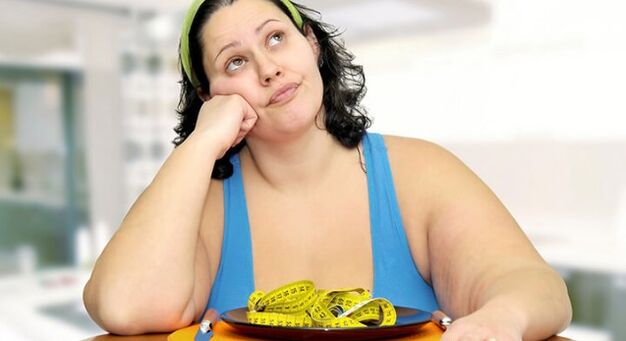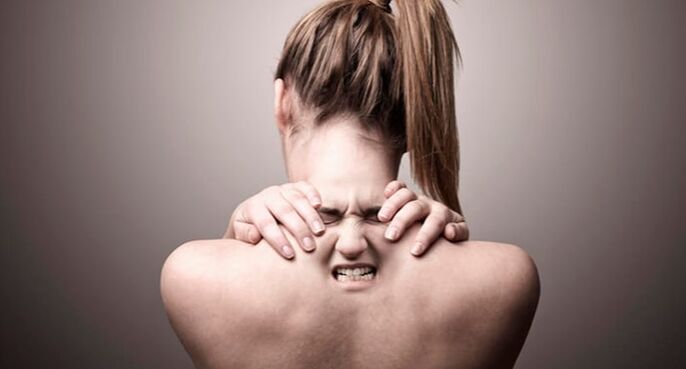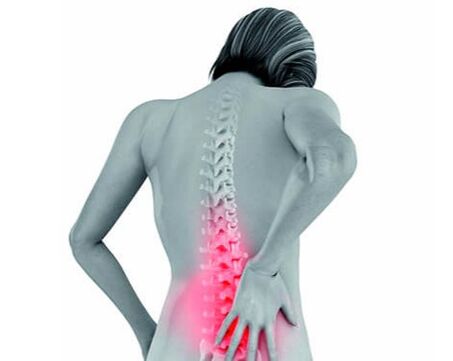Osteochondrosis is a well-known pathology for 40% of the population under the age of 35-40 and almost 90% in old age. Even in adolescents, sometimes signs of osteochondrosis are discovered - a decrease in discs, pain, discomfort in the spine. If you start treatment of the disease in the first stage, before the disk destruction, the chance to stop progress is very high.
What is osteochondrosis?

With osteochondrosis of the spine, one or more intervertebral discs occur. The disease can occur in any department:
In severe cases, degeneration of vertebrates against the background of osteochondrosis is observed throughout the pillar, which causes human disability. So what is this disease - osteochondrosis? The pathology is associated with a gradual, stable and progressive violation of hyaline cartilage food located on the intervertebral discs, as a result of which they change their position, shape, crack. A person experiences a severe pain syndrome, functions of the entire skeletal muscle system are damaged.
What is osteochondrosis about its consequences? If you do not perform treatment, the beads will be compressed, the cracks between them will sit, and the drives will appear to be destroyed. This will lead to damage to the nerve roots, spinal cord damage and damaged work of the internal organs. Bone osteophytes appear along the edges of the disc - growth that cause even more pain. The consequences of this spinal disease are very serious.
The main causes of osteochondrosis
Scientists concluded, studying osteochondrosis that this disease is a consequence of a person's justice, so most people are subject to it. High daily loads on the back, deterioration associated with the age of vascular functions, food inferiority and aging of the body are the main causes of osteochondrosis. The following factors are weighed by the situation:

Injuries, severe physical activity greatly exacerbates the development of spinal osteochondrosis. Therefore, athletes, physical labor workers, lower back osteochondrosis - a very "popular" problem. Inheritance also plays an important role in the pathogenesis of the syndrome - if parents at an early age had serious problems with their backs, the child has a high risk of getting spinal disease.
Psychosomatic of osteochondrosis
The psychosomatic causes of the pathology are a new direction in the search for prerequisites for its formation. Psychosomatics implies the impact of psychological factors on the development and course of physical illness. The link between bodily and mental problems is really stuck, and in appearance a healthy person can suffer from regular pain. With osteochondrosis, some people have no objective causes for pathology, but it continues to progress.
Up to 30% of patients after a visit to the doctor show problems such as:
The stages of the disease
The intervertebral disc consists of liquid and solid parts. The first is in the center, representing a nucleus that gives elasticity. The core is surrounded by a strong ring from above. With the liquid structure that starts all the pathological changes in the disk, which later spread to its shell.
In medicine, four stages of the development of osteochondrosis are distinguished. This refers to the conditional unit of pathology from the severity of the spine violations:

Symptoms of osteochondrosis
The first signs of osteochondrosis usually begin in the initial phase when there is still no pain. At the neck, at the bottom of the back, less often - in the chest region when moving, you can hear a cramp (this means disk power violation, its dehydration). Further, during congestion, working in an unpleasant position, a person can mark the stiffness of the back or neck muscles. They become "stone" on one or two sides, which is unpleasant, causes burns, irritation.
Subsequently, the symptoms of osteochondrosis become more noticeable. At rest, a person can feel normal, but work, lifting weights, a dream on an unpleasant pillow can provoke such phenomena:

When overloading the patient's spine, osteochondrosis gives more pronounced signs and symptoms. The pain appears on the shoulder, gives her in his hands, elbows appear, headaches. With osteochondrosis of the cervical spine, ear noise, dizziness, vertebral artery syndrome develops, and vision is disturbed. Over time, no muscle atrophy occurs without treatment of osteochondrosis, the skin becomes pale. The course of heart pathologies can be aggravated, the work of the liver, gall bladder and gastrointestinal tract is terminated.
Which is the pathology leading?
The consequences of this disease are always uncomfortable, they provoke an increase in pain. With osteochondrosis, there are:
The risk for a person depends largely on the type of hernia for osteochondrosis of the spine. They are front, rear, side and most dangerous are the rear hernias - they can squeeze the spinal cord. In the lumbar segment of the spine, hernias are more common, mainly between 4-5 vertebrae.
Lumbar osteochondrosis can cause very unpleasant symptoms - lumbago. Lumbago pain is burnt, sharp, unbearable, it is very difficult to endure. The cause is adjacent to the nerve because the patient is damaged by a neuromusive package. Particularly dangerous for osteochondrosis of the horse's tail syndrome, when a person has a top of a large spinal nerve pack. As a result, intestinal functions, bladder, and even foot paralysis can occur.

Signs of osteochondrosis often descend to severe muscle atrophy. If the muscles do not participate in the body for a long time, the spine movements are limited, then individual fibers weaken. As a result, the patient can become a person with chain disabilities in bed. Cervical osteochondrosis is also very dangerous because a hernia in this segment can cause a violation of blood supply to the brain. At this stage there is a risk of visual damage, swallowing, speech and other brain functions.
Diagnosis of the disease
Knowing the signs of osteochondrosis independently, you should think about its treatment. Since the spine lesion can reach different stages, the treatment of osteochondrosis will also be uneven. It is important to make the correct diagnosis so that the therapy is chosen correctly.
Due to the widespread spread of the disease and the presence of characteristic symptoms, the doctor will be able to take a diagnosis on a prior examination. But for the differentiation of osteochondrosis from other diseases of the posterior and internal organs, the following diagnosis is performed:
With osteochondrosis, laboratory tests do not play a major role, but the distribution of general tests, biochemistry is required to exclude the inflammatory process, rheumatoid lesions of bones, joints. To study muscle function, the doctor performs a number of physical tests and to clarify the work of blood vessels and nerves, they do a double electromotion.
Treatment of osteochondrosis drugs
If the symptoms and treatment of osteochondrosis are determined, it is not worth delaying therapy - the disease progresses rapidly. At an early stage, gymnastics is usually recommended, massage to strengthen the muscles - this will be enough. In the remaining stages of osteochondrosis, drug treatment, and sometimes surgery will be needed.
Pain relief is the most unpleasant sign of the disease -you can use non -steroidal anti -inflammatory drugs. They cannot cure osteochondrosis, but they are always prescribed before exercise therapy to relieve symptoms. In severe cases, medicines are administered in injections, but most often they are recommended by a course of 7-14 days in tablets and in the country, in the form of ointments.
If a person has a strong painful syndrome in the spine, it is injected with glucocorticosteroid injections directly into the damage area.
The treatment of osteochondrosis is also performed using the following tools:
If osteochondrosis is developed, then only chondroprotectors give anesthesia and pathogenic treatment, they are taken in courses for 3-6 months. The rest of the medication have the symptomatic effect and do not affect the course of osteochondrosis itself.
Physiotherapy and osteochondrosis

In the list of measures than to treat osteochondrosis, physiotherapeutic techniques necessarily include. Thanks to physiotherapy, the treatment of osteochondrosis will be more effective because the action extends directly to the focus of inflammation. Physiotherapy will relieve painful syndrome, eliminate spasms, improve blood microcirculation, help remove clips from the nerves. The most popular methods are as follows:
All types of physiotherapy should be performed with courses of 10-15 procedures, while individual contraindications are necessarily taken into account.
Gymnastics and massage
Exercise therapy in the treatment of osteochondrosis plays a dominant role. Without exercise therapy, it will not be possible to form a strong muscle corset, and the latter is very necessary to hold a diseased spine. Also, gymnastics increases blood circulation in the vertebral area, improves metabolic processes and helps to rapidly remove decay products.
How to cure osteochondrosis with gymnastics? The complex is selected only individually, and only in stages 1-2 can be performed without a doctor's control. In later stages, unnecessary, stronger movements can cause disk distribution and strengthen the problem. In 3 stages, all exercises are done only in a lie position.
Massage is required for the treatment of osteochondrosis. In the acute phase, they do not do it - it will cause an emotion. But the massage performed correctly in the chronic phase with osteochondrosis is necessary. After the course of the sessions, the muscles rest, the clips are removed, the nerves and blood vessels begin to function normally. Massage is performed only softly, with no sudden movements.

Preventing pathology
In order not to bring into operation for osteochondrosis, it is important to carefully consider prevention measures:
It is also important to eat well, do not smoke, enrich vitamin diet, consume more fluid - so the probability of pathology will decrease.






















